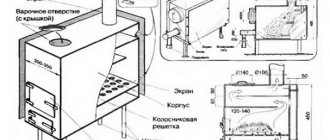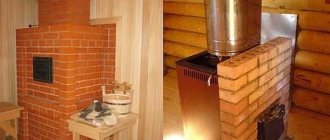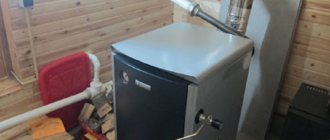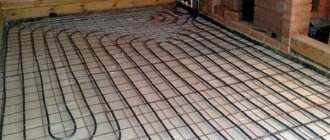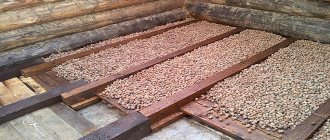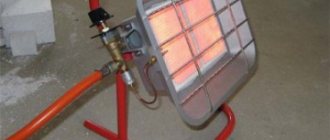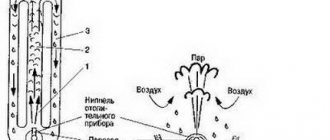How to warm up in the cold season?
Since, according to the conditions of the problem, our bathhouse does not have central heating, we will consider all other options.
Let's start with the fact that there will be no problems with heat in a small bathhouse, which is entirely heated by a stove installed in the steam room. If the interior spaces are large enough, the power of the oven, as well as direct contact with it, will not be enough for everything. And this is where options for alternative heating of a bath in winter begin.
Boiler
What is one of the first ideas that comes to mind? For us it was a boiler. In general, the main purpose of a sauna boiler is to heat water for washing. But we are free to use it to heat the bathhouse in winter.
By the way, now this word is used to describe any water heater. Therefore, by and large, the tank in which the stove heats the water could also be called a “boiler”. autonomous this way .
In turn, these autonomous boilers can be powered by different fuels - electric, gas and wood. The second important division is into flow and storage.
Everyone chooses the type of fuel according to their capabilities and the capabilities of the area where the bathhouse is located. Somewhere there is no problem with gas, somewhere there is no problem with electricity, and somewhere only firewood is the only available resource.
Let’s say on our own that the electric option is the simplest, lightest and cleanest. Well, more or less safe (if you have a automatic rifle). For gas you still need to get permission, but with firewood... well, everyone knows how to handle firewood.
As for the flow-through or storage options, everything, of course, depends on the power of the boiler. In winter, a flow-through system may simply not cope with the task of heating water to an acceptable temperature.
Sunsystem indirect heating boiler. Photo by Leroy Merlin
ADVICE! If you use a boiler in a bathhouse in winter for heating, it is better to use a storage boiler.
Another question: how to warm up a bathhouse in winter using a boiler? batteries in strategic places and power them from the boiler. It is clear that as a result we get a water heating option .
You could just as easily use a stove and make it heat the water in the tank. But there is one caveat: the power of the furnace is not unlimited. By forcing it to heat the tank, we increase the overall heating time. Of course, you can take a more powerful stove, but then what will you do with it in the summer, when there is no need for heating? Specifically for this situation, an autonomous boiler for water heating batteries is a reasonable idea.
From the stove in the steam room
We have already said that the power of the stove may not be enough for all rooms, but if the opposite is true, and the stove is powerful, then what to do with it in the summer?
One of the options for solving the problem is to position the stove in the space of the bathhouse so that it is at the intersection with several rooms, and its heat spreads everywhere. But here again there are doubts about summer. Therefore, most often they simply make the firebox exit into the rest room, which gives some warmth to this room.
Heating in the bathhouse in winter from the stove. Diagram from an article about ventilation.
The second option for heating a bathhouse in winter from a stove in a steam room is to install a heat exchanger and supply water from it to a water battery system. We wrote about heat exchangers here.
But just remember! The redistribution of heat from the furnace affects its performance. The heat used to heat water increases the consumption of firewood or other fuel . You can reduce it if you place the heat exchanger not inside the stove, but on the chimney pipe, in which heat is still lost.
But should we assume that installing batteries automatically makes the bathhouse heated? We think heating is a matter of consistency. The bathhouse will be heated if, after completing the procedures, the batteries continue to work until the next visit. And if they work only while the owner is on the site and uses the bathhouse, then the bathhouse remains unheated - when leaving, everything must be turned off and the water drained.
Pay attention to the heating radiator under the shelf - it needs to be either drained or constantly heated.
IMPORTANT! Do you remember that at temperatures from zero and below, the water in the pipes bursts? If you don’t want to change the communications, you need to drain the water or insulate the communications themselves.
In general, you can make batteries and fill them with hot water either from the stove or from the boiler.
Other options
You can do without heating water for heating altogether. This is if you make warm electric floors in rooms where the heat of the stove does not reach. A fairly common option, but only for those settlements where there are no frequent problems with electricity. Well, for those owners who are not faced with the need to save on everything.
An alternative to underfloor heating for heating a bathhouse in winter can be the installation of portable heaters - oil, infrared or any other design. As a last resort, you can use a small wood stove, for example, a potbelly stove, which will take care of heating, say, a rest room.
You can speed up heating using a heat gun - a cross between a heater and a fan. In this case, the air will heat up faster and more evenly. It is clear that a heat gun should not be used for production purposes.
There are many options for heaters - these include wall panels and stand-alone models. They can run on electricity and gas. Installed where needed, as desired. Perhaps this is the simplest and most practical way to warm up a bathhouse in winter everywhere except the steam room.
Heating from the central heating main
In this case, we are not talking about thermal heating pumps, although devices that can provide heating for several buildings on the territory of one household are already being actively sold in Europe.
Experts recommend not looking for futuristic, obviously time-consuming and expensive methods of heating bathhouses, but simply choosing the appropriate option for heating the bathhouse from home.
The economic part of the solution to the problem is obvious:
- There is no need to buy expensive gas or electric boilers. Laying communications from the heating boiler in the house to the collector in the bathhouse will cost an order of magnitude less;
- There are no grounds for possible claims from Energonadzor, fire and gas services;
- The larger the heating boiler, the higher its efficiency, so the kilocalories of heat obtained from a home heating system will be cheaper than the energy obtained by burning gas in a low-power sauna appliance.
The only significant problem is the correct choice of insertion scheme into the heating circuit of the house. Typically, water heating in a private house is built in the form of a closed ring with convective or pump supply of coolant.
If you try to simply cut a pipe into the “hot” part of the manifold of a heating boiler at home, then due to different hydraulic resistance in the pipes, a “stagnant” zone may form in one of the lines. Simply put, all the heat will either flow mostly into the bathhouse or remain in the heating system of the house.
To ensure that stagnation and the complex balancing procedure using throttling washers are avoided, when connecting a bath, an additional boiler with a heat exchanger built inside is used. The reservoir is included in the heating system of the house, the internal circuit is connected to the heating pipes of the bathhouse. The hot water accumulated in the boiler will be used as a thermal buffer, which will prevent the pipes of the main system from cooling down in the winter.
We heat for heating
Frost creates additional requirements for how we heat a bathhouse in winter.
How to drown
The rooms become cold, approaching the temperature of the environment. In this case, heating immediately causes the appearance of condensation - water vapor from the air strives to instantly settle on something colder than the air itself.
The process of kindling in such conditions becomes an art. what type and fuel you use is also of great importance . It is difficult to cope with a brick stove; an iron stove is simpler in this regard.
There was a video on the Internet, the author of which shares his experience of lighting a Feringer stove at sub-zero temperatures:
But this is not so much about art, but about whether a small stove can bring a steam room out of the red in an hour. The author clearly shows that he can.
We want to say that you can’t break time records with a brick, but if it happens in winter, and the bathhouse has cooled down to sub-zero temperatures, then you need to be more careful with the stove.
After a cold period, the brick oven is first slowly heated and the moisture is allowed to evaporate.
The video below shows the process of heating a brick stove in a house, and this is somewhat different, because in the house the stove is not overcooled, it does not need to be gradually turned into positive mode, besides, it has a different operating mode - it is heated only in cold weather and constantly, and the bathhouse is heated for procedures at any time of the year. But so far no one has made a video about how you can heat a bathhouse in winter with a brick stove.
How can I heat it?
The question “how to heat a bathhouse in winter” can be answered in two ways - talk about what kind of firewood is best suited for winter heating. Or how to achieve a comfortable temperature for a person in rooms other than a steam room. Above, we have already talked about alternative methods for heating a bath without heating in winter.
Therefore, here we will only say that the only fuel quality depends on us is firewood. And you should know that this quality determines how well your stove will work. Specifically, how long will your chimney last without cleaning?
This is influenced by the presence of resin in the firewood - firewood made from coniferous wood is, of course, the cheapest, but it also creates the most problems . Because during combustion, more soot is formed, which settles in the chimney pipe.
Hardwood is much better in the firebox. But they also differ in the heat of combustion. Unfortunately, valuable hardwood species - oak, hornbeam, and ash are good for burning. But, on the other hand, not all of their wood is suitable for processing and turning into building materials, furniture or something else.
Fruit trees (cherry, apple, etc.) are suitable for heating; they are only slightly inferior in heat of combustion to the species mentioned above.
Next come deciduous trees, but not so rare - birch, alder , etc. It is better to use them than conifers.
Another important characteristic of firewood is its moisture content. The damper the wood, the worse it burns, everyone knows this. Therefore, the woodpile should be located in a dry place, protected from precipitation, and you can also dry the wood next to the stove, using its heat to drive out excess moisture from the wood, which will then go into the firebox.
How to heat bath rooms
Let's take a closer look at the issue of heating rooms such as the dressing room and the rest room.
Waiting room
There are different waiting rooms. For some, it’s just a vestibule, which does not allow the cold air from the street to cool the room when people enter the bathhouse; for others, it’s a full-fledged hallway where you can undress and dress; for others, a combined room is called a dressing room - this is both an entrance hall and a relaxation room , there is both a hanger and a table, roughly speaking.
In what case should you worry about how to heat the dressing room in a bathhouse in winter? We believe that in the last two cases. Because there is no point in heating the vestibule, but it is definitely worth insulating it.
There is one heating method that does not seem to require any special costs. This is the use of ventilation. The method is simple: make a hole in the wall of the steam room, insert a plastic sleeve into it, and install a fan inside the sleeve, which drives hot air from the steam room into the adjacent room.
ATTENTION! Since this function is not always needed, care should be taken to block the air flow from the pipe. This is done using an adjustable plug.
The easiest way to do this is in the following video:
And this video shows a slightly more complicated version of the same thing:
That is, it is not necessary to use the simplest design; you can improve it to suit your conditions.
What is good and what is bad about this method? The good thing is that with an iron stove you can lower the temperature in the steam room; it is better to heat the stones in the heater and get a mode that is closer to a Russian bath.
Although this is not the main thing, the main task is, after all, heating the adjacent room. Well, this method copes well with heating. This is approximately the same as a heat gun - warm air that is driven by a fan . And this combination quite quickly raises the air temperature in the room.
The downside is the same as the upside - you lower the temperature in the steam room. How does this happen? Well, if you organize an outflow, then the inflow will increase, and our influx is either from the street or from the next room. By the way, if he is from the next room, then the idea is bad, because this way we will completely deplete the air of oxygen.
Lowering the temperature will increase fuel consumption. But here it is worth noting that everything depends on a subtle relationship of factors: by varying the changing parameters, you can ensure that the temperature in the steam room is the temperature you need, while in the next room the temperature rises due to ventilation. As you set it up, so it will be.
In our opinion , using ventilation for heating is a good way to achieve the goal.
In addition to this, of course, no one bothers to use additional heat sources - heaters, heated floors , etc.
Other options assume that they were taken care of during construction - this is when the stove goes out on different sides into different rooms , for example, into the washing room and into the rest room.
is usually made in the recreation room , bringing the firebox out there. But the same output of the firebox can also be carried out into the dressing area. However, it will take a long time to wait for significant heating. And ventilation is much faster.
IMPORTANT! The brick stove has a summer damper that blocks the passage of additional channels that take away heat. Therefore, in summer, hot air from the stove immediately goes outside. But if an iron stove is located on one side in the steam room, and on the other in another room, then in the summer it will be very hot in the adjacent rooms. Still, ventilation in this sense is more humane, and besides, it is blocked.
Rest room
We have already talked about the ventilation method above. It is suitable for those whose KO is separated by a wall from the steam room. But even if there is no adjacent wall, you can connect the steam room and the CO using air ducts.
All other ways to heat a relaxation room in a bathhouse in winter assume that it will contain one or another heating devices: you can extend water heating registers there, install wall panels , or make do with portable heaters.
option is also suitable .
How to make heating in a bathhouse - choosing a heating method for a steam room
Visiting a Russian bathhouse has become a family tradition for many.
Many owners of private houses want to install a sauna building on their plot, but they are often faced with the problem of arranging heating. There are several ways to heat a modern steam room and other rooms located in the bathhouse. The choice of the type of heating structure depends on the financial capabilities and wishes of the owners. Since the steam room is used from time to time, therefore, before heating the bathhouse, it is necessary to decide how this building will be used.
If you plan to not only steam in it, but also do laundry and take a bath, then using a conventional stove for heating will not be entirely convenient.
Modern methods that make it possible to provide heating in a bathhouse all year round are varied, among them the most popular are:
- electric floors;
- installation of water heating;
- installation of a “warm floor” system and others.
Drying the bath
There are two components to quickly drying wet rooms: heating and ventilation. They should not be considered separately, because together they work most effectively. You just need to combine them in a specific case.
How to dry: ventilation methods
The ventilation system is laid at the stage of construction of the bathhouse (see here about the diagrams and design of the bathhouse ventilation). Therefore, if something is forgotten, it may be too late to redo everything.
vents are usually made in the foundation - these are through holes lined with sewer (most often) pipes that lead to the underground space. They have plugs on the outside that allow you to open and close them at the right time.
More details about the scheme can be found here
Such vents are opened only after procedures. And they serve for better ventilation and drying of the bath.
Also, another through hole is usually made in the wall of the steam room under the shelves On the inside it has an adjustable plug. This hole is also used to speed up the drying of the steam room.
You can dry the bathhouse in winter with the help of ventilation by opening and doors wide - after all, the air inside is much more saturated with water vapor. But you shouldn’t think that all the moisture will leave the bathhouse only thanks to open doors and windows.
In addition to ways to create a draft simply by opening holes, there is another method where ventilation actively cooperates with heating and works when the stove is on - this is bastu, which you can read about here.
Well, don’t forget that even if natural ventilation is not installed correctly or its power is not enough to ventilate the bathhouse, you can always install fans in the air ducts . Forced ventilation, although noisy, is still effective.
BY THE WAY! Heat guns can help here too.
For those who believe that heating alone is enough, and ventilation becomes optional, we recommend watching the video by Konstantin Bely:
